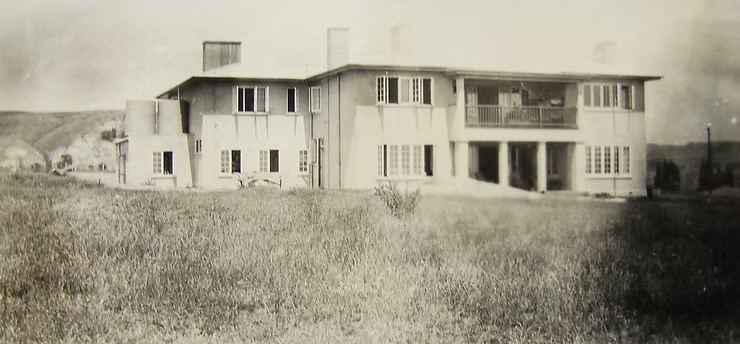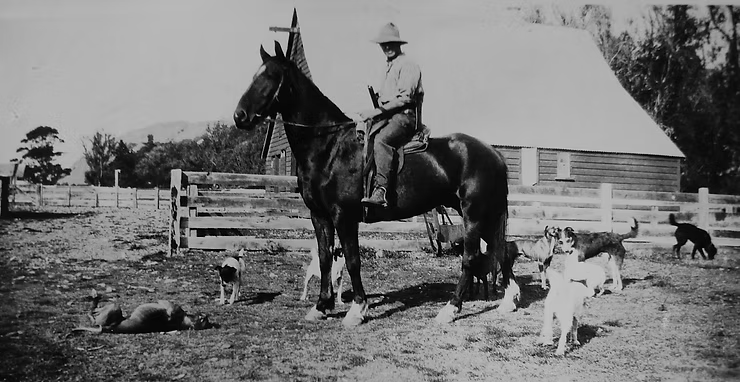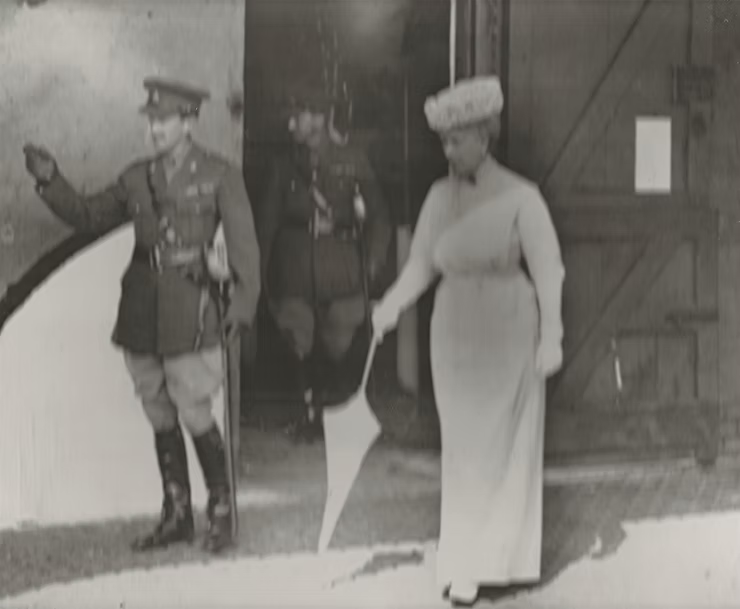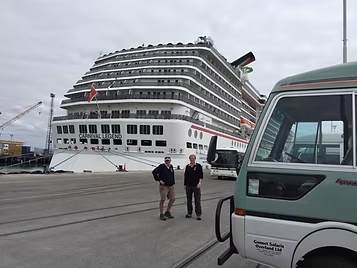Transforming the Cape (Part 1 of 2)
- Keith Newman
- Aug 19
- 10 min read
Updated: Sep 3
Neilsons at Summerlee
Summerlee, the luxury homestead tucked beside the old Te Awangawanga o Te Hawea pa site at Clifton with expansive views across to Napier, was once part of a vast estate that encompassed all of Cape Kidnappers (Te Kauwae-a-Maui).In October 1924, Frank Gordon, the grandfather of present Clifton Station owner Angus Gordon, sold 5175 acres (2094 ha) of family land, including the Karaka Hill site, to Colonel William Neilson and his wife Maude.
The colonel, a Scotsman based in Northampton, England, formerly of the 4th (Queens Own) Hussars, had after his long military career resigned his commission in 1922 and had been looking for somewhere to settle down.
After being enamored with the country during a visit to the South Island, a cousin in Hawke’s Bay drew his attention to the Clifton property which had just come onto the market. “It was certainly an extraordinary piece of country but without the babbling brooks,” said Andrew (Andy) Neilson, referring to the glamorous marketing that had caught his grandfather’s eye.
Frank and Dorothy Gordon liked the idea of cultured English neighbours, so they had advertised the considerable estate in Country Life and Field magazines in England. The wording conjured up a vista of rolling countryside, freshwater streams with ample opportunity for game hunting and fishing although that was far from the reality.
After riding over the Cape Block, from the foothills bordering the Maraetotara River to the tip of Cape Kidnappers, Colonel Neilson eventually haggled the price down to £13 an acre, or £67,275. However, he continued to claim he’d been deceived by the advertisement, believing all the gullies drawn on the map were actually rivers and creeks not dry riverbeds. They got over that, says Andy, although there was some consternation between buyer and seller for a while including the Colonel’s continued use of Clifton’s woolshed.

Difficult to farm
“It was a long and narrow property and difficult to farm. The best grazing country is at the Cape end; the roughest at the Te Awanga-Clifton end. It ... required hard work to make it viable ... you couldn’t just live on the view.”
Colonel Neilson was aged around 40 when he and Maude first arrived with their children David,15; John, 14 and Nigel,13. They rented a cottage in Te Awanga, while they built their first cottage on Karaka Hill and were developing the two-storey stucco homestead.
The homestead, completed in 1926, was named Summerlee, after the Summerlee Ironworks in the coalmining area bordering Glasgow where members of the Neilson family still live. James Beaumont Neilson, the grandfather of Colonel Neilson, patented a process in 1828 which burned waste furnace gases to heat up a lattice of fire bricks in regenerative stoves creating a ‘hot blast’ process for extracting iron ore rersuting in the creation of a foundry.
Andy Nielson says for many years an engine painted yellow with the plaque still on it, an example of his great grandfather’s workmanship, remained at Napier’s Marine Parade playgrounds. “When I realised it had gone I went to the council but they told me it had been scrapped. There was another in the Featherston Museum so they were definitely used in New Zealand.”
Preparing the way
Amy Winmill was among those sent out from England in 1926 to help run the enormous Summerlee homestead. She met and married Jack Lambert, a local character who kept the rabbit population down from the Cape area down to Ocean Beach and across to Craggy Range and the Tukituki valley. The couple establishing their own home at Pipi St, Te Awanga.
Amy ran cows and supplied milk, cream and butter to the locals. Their children were Myrtle, Michael and Beryl. Annie Coleman arrived on the M. V. Rangitira on 3 October 1930 with her 14-year old son Arthur to join the Summerlee staff. They were met at the Hastings train station by gardener Victor May and his wife and driven in a Model T Ford to the property.

Arthur Coleman’s first job required a lot of energy for a 14-year old boy; hoeing the long metal drive and later helping the head shepherd and station hands with docking, mustering, dipping, shearing and other tasks. Annie, who’s partner had died at Flanders in WW1, Amy was 41-years old when she arrived in the country. She and Arthur remained at Summerlee for three years before taking other employment.
Horseback shake-up
Andy Neilson says the colonel was on the south coast of the estate just before lunch on 3 February 1931 when the Hawke’s Bay earthquake struck. “His horse started acting up and he didn’t realise what had happened until he was back up on the top of the Cape and could see the fire and smoke coming from Napier.”
The youngest of the Neilsons, Nigella was born on sofa in the living room at Summerlee days after the quake. The doctor forded rivers on horseback from Napier to come to the homestead as it wasn’t safe for Maude to come to him.
Frank Gordon agreed to let Colonel Neilson use Clifton’s woolshed, yards and dipping facilities until he could build his own. That arrangement continued for a decade while Frank paid out his three sisters from their father’s legacy and settled all loans to the station.
Colonel Neilson still owed a large mortgage on the property and a disputed amount was eventually reduced then wiped due to changes in government policy. That contributed to growing tensions between the Gordon and Neilson families requiring all correspondence to be conducted through lawyers.
Colonel Neilson eventually built his own woolshed below the homestead in 1935 but still needed to bring his sheep along the same route, where they had been grazing at the far end of the Cape. It was a perilous exercise which needed to be undertaken at low tide. That process continued even after Frank had donated the beachfront to the Crown for the Clifton camping ground in 1936. People bathing and swimming and sunbathing simply had to put up with Neilson’s sheep dogs and herds passing by for the next 15-years.

Top sheep dog trialist
Andy says ‘the Colonel’ took up dog trialing and managed to get himself up in the top level in New Zealand. “He was second in the North Island sheep dog trials in 1937 with his huntaway.” He wasn’t really interested in the frills of life, he’d done pretty well in the army and just wanted to settle. “He was a fairly determined, quietly spoken old fellow with stickability.” He encouraged all his staff to get involved in a sport or engage in dog trialing, “he probably had two of the top dog trialists in New Zealand working for him, Alan Cochrane and Pat O’Rourke”.
The colonel kept "soldiering on" after the Depression of the 1930s with Sid Stark as his only worker until his son David returned after WW2.All three sons survived the war to return to Summerlee. David had spent much of the war in a prison of war camp in Germany, Jon (Jonathan) was in the RNZAF bomber command rising to the rank of squadron leader and awarded the DFC in May 1944. Nigel joined the Staffordshire Yeomanry and ended up in the equivalent of the SAS, earning the Military Cross.

Andy says the Colonel’s wife Maude was a real character. “Very musical and loved the theatre...a real force to be reckoned with...a true Victorian. She and the second Mrs Frank Gordon got on really well and kept things going in the area. "They used to have drama competitions in those days between Clive, Whakatu, Haumoana and Te Awanga with one or two act plays and she was very involved in those”. Nigella followed in her mother’s footsteps and was well known in Wairarapa and Wellington circles for her productions of plays and musicals.
Relationships restored
It was that relationship between Frank’s wife Dorothy and Maude Neilson that created a more genial buffer in the strained relationship between their husbands, along with friendship between David Neilson and Frank’s son John Gordon. David arranged to construct a bridge across Rabbit Gully about 1953, which cut out about an hour’s drive around the boundary.
“They then pulled the old woolshed apart and re-erected it at what we called the middle of the farm”. Bambry brothers transported it to its present position overlooking the Kidnappers golf course. By that time the farm had four single shepherds and a married couple helping run things. The family however remained “pretty isolated” with a single wire phone up to the main house.
David Neilson believed he could develop Summerlee into a viable proposition and, despite his father’s misgivings, began to do just that. While the Colonel was starting to show the land to prospective buyers his son did all he could to discourage them. When John Mason, the grandfather of the founder of Sacred Hill winery showed an interest, David drove him through the roughest parts of the farm on the bumpiest tracks, pointing out all the worst features. His father was perplexed when interest waned.
David left for England with his wife Diana and four children in 1955 to take over running Catton Hall in Derbyshire which his wife Diana had inherited. Andy, who was only around eight years old at the time, recalls his grandfather struggling with Parkinsons disease and fading health before he died in the 1960s.
The Colonel’s death placed further pressure on the struggling farm enterprise. “This happened at the worst time with the impact of the Labour Government’s notorious Black Budget having a major impact on the country with export prices hit hard, import restrictions increased and taxes ramped up on beer, tobacco, cars and petrol and imposition of estate and death duties.”
Next generation ownership
Son Jon Neilson and his wife Sheila (Andy’s parents) took over running the farm. Maud Neilson remained on the property until her death in 1967.
Jon had come to New Zealand in 1925 when his father first purchased Summerlee. He was a long serving member of the Gannets Board, which presided over the Gordon family legacy of protecting the largest inland gannet colony in the world. He died at Summerlee aged 70-years in August 1986. His wife Sheila then purchased a house in Te Awanga. Their son Michael took on management of the property.
Michael and his wife Jo lived at Summerlee. When the couple split Michael moved with new partner Lynn Allam into the renovated general shepherd’s cottage belonging to his sister Alexena. When his younger brother Andy, the youngest of four children, returned from overseas in 1973, they purchased the family interests and he and his wife Billie shifted into the Summerlee homestead where they raised their children.
While Summerlee had been re-roofed and painted, Andy says not a lot else was done before he and Billie moved in. “It was well positioned to get the sun most of the year round. It was a great place to live, raise kids and entertain with fireplaces at both ends”. The couple renovated the bathrooms and jibbed it in places but found it was well insulated with roughcast, sarking, framing, scrim and wallpaper. “It wasn’t a cold house as long as you closed strategic doors at the right time”.
Andy and his brother ran sheep and cattle until Michael sold up and eventually moved to Taupo. “It was always hard work, compounded by a drought every seven years.” They completed strategic fencing and to alleviate water shortages established three water schemes including catchment dams.
Hard, dusty terrain
The pressure increased year on year with fewer staff expected to manage more stock per person to make it work. “We ran 6000-7000 ewes and about 600 cows, almost double the stock of my grandfather’s day,” says Andy. “It was hard and dusty at times but the best time of the day was 4am, mustering on horseback heading toward Ocean Beach and watching sunrise ... unbelievable.”
Goats were a big problem. “We’d round up about 1000 and push them into the cattle yards but by the time we got them there most had escaped. We would only have about 200 to send off to Affco in Wairoa.” And then there was culling by helicopter. “We’d just shoot them like in the old deerstalking days, jump out, take the paunch and share this between the pilot and ourselves. ”He says live capture worked for a while when people were looking for animals to breed from for the mohair market“. Then when forestry started we really had to nail them because they’re lethal on young pine trees".
Andy says rabbits and possums were always a problem breeding in the gullies and coming up in the night. “We had a lot of night shoots, they were all competing for the feed with the sheep and cattle”.
Gannets Overland begins
Jon and his sons Michael and Andy started Gannet Safaris alongside the Hawke’s Bay Motor Company which ran the business from Napier between 1969-1979. “Then they announced in September 1979, just before the October season was about to begin that they weren’t going to do it anymore”.
The Neilson brothers had outsourced the business because requests from family, friends and the general public to see the gannets “got out of control and was in conflict with the farming business”. With interest still high the Neilson’s began running their own tours from the 1979 season.
Andy joined the HB Tourism Board encouraging local tourism, and along with four other parties began to develop the cruise ship market for the region.“We tried hard to get Hawke’s Bay on the tourism map for a long time then we realised why the government wasn’t interested; they had invested in their Tourist Hotel Corporation with hotels in Rotorua and other places and were steering everyone there.” Regardless Neilson and others built the local market and thought they were doing pretty well “getting eight cruise ships here in a year but now (pre-Covid) you get about 68.” It certainly bumped the turnover up for what was is now called Gannets Overland,” says Andy.

Gannet Overland were giving visitors and tourists a farm experience at a time the town was quickly splitting off from the country. “People no longer had an aunt or an uncle in the country where they could go and stay during the school holidays, so it became a farm tour with a little history thrown in for good measure on the way to the gannets.”Andy and Billie remained on the property until they sold to Robert Fisher in 1997.
Moving wasn’t easy. “It was the first time it had had a proper clean up since 1926.” As the Neilson’s were packing up and preparing to leave the property, Louise Brightwell, the daughter of Colonel Neilson’s first housekeeper, went out to Summerlee and was given a guided tour. She noted “the pelt of a fully grown tiger hung from the top of the stairs to nearly the bottom” and was shown her grandmother Violet Annie Coleman's reference papers.
Determined to remain in Hawke’s Bay, Andy, who now runs a waste disposal company, drove around looking at places he’d never been before, finally settling on a farming property on Waimarama Road. Sources: Photos from the Jonathan Arthur Neilson (1926-1928) album Interviews with Andy Neilson and Louise Brightwell Jonathan Neilson Obituary, HB Today, 08-08-86 Angus Gordon, Shadow of the Cape, 2004, p.117




























